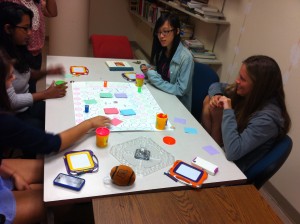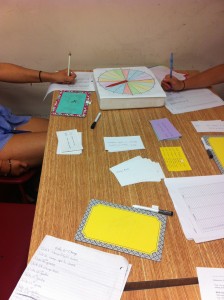I jokingly described the last game our team was struggling with as a helicopter going down in flames. Fortunately, that game is now in good shape and we are heading toward play testing. However, with only two weeks left in the program, there is still one last game to develop for the high school students. If the previous game was a helicopter in flames, then the current game is a flaming helicopter sitting in the bay of a cargo plane filled with fire ants, hurdling at breakneck speed into the side of mountain. And each ant has its own tiny airhorn to insure the journey is as unpleasant as it is lethal.
Sometimes I just need to vent.
Conflict appears to be an inevitable part of the artistic process, but that struggle must be weighed against its impact upon the relationship of the participants. People should always come first, especially students. However, there may be some bumps and bruises along the way. I used to live in a self-imposed utopian fantasy where all collaboration was effortless and combat free. But then I saw Mirra Bank’s film The Last Dance, a documentary about the collaboration between Maurice Sendak and Pilobolus. Sendak, most noted for his book “Where the Wild Things Are,” is a brilliant storyteller. He is a master storyteller who can use linear narrative to convey powerful ideas in simple ways. By contrast, both the origin and the creative process of the dance group, Pilobolus, borders on anarchy. The group was created by atheletes who considered themselves outsiders to the modern dance world, and their choreography is borne from unstructured improvisation. During their collaboration on a dance piece about the holocaust, Sendak and Pilobolus butted heads constantly, and their falling out almost caused them to abandon the project. However, the creative struggle resulted in a brilliant compromise between improvisation and storytelling that could not have been achieved by either party alone. We have a similar struggle when working with students. We must develop a tangible product of genuine scientific merit and social impact while retaining student interest in the scientific process. In working on this game, I learned that it’s sometimes necessary to momentarily sacrifice one of these goals in order to make it to the finish line. The reward for making this sacrifice is that all three may be restored upon completion of the game. A momentary sacrifice of the project goals may serve to regain student interest, which in turn fuels the project forward.
There were several difficulties in designing this game. It took a long time for the student to feel secure with her topic. This lack of security most likely resulted from not spending enough time learning about the topics in detail. She also found it very difficult to implement her topic as a game because she did not fully master the principles of game design. As I discussed in a previous post, switching topics is fine, but the penalty can be severe when time is short. Students typically switch topics because they don’t have the skills or resilience to overcome obstacles in the design process. This lack of experience and patience, at its worst, can result perpetual topic switching that leaves the student with nothing to show for their effort. It’s our responsibility as facilitators to urge them forward, even if you have to be momentarily villainized as a slave driver.
When a project is going well, the best thing an advisor can do is step aside. It might be counterintuitive to step aside when a project is not going well. We reached a point in the struggle to come up with a design where any suggestions I made were met with immediate resistance. I remember several times in my graduate student days when I resisted all input from my advisors. I knew that any suggestions by my mentor meant more work, late nights, and missing my friends. It was far easier to push against the people that were trying to guide me than it was to do the work necessary to fix the project. While you might be able to convince a graduate student to forgo a party to spend a Friday night pipetting until dawn, you are guaranteed to have a more difficult time with high school students. Teenagers are not always rational agents. The prefrontal cortex of teenagers is still developing connections to the rest of the brain, which limits their ability to make deliberated decisions or control emotional outbursts. Nevertheless, teens are incredibly shrewd. They know how to maximize a short-term reward and minimize short-term punishment. Unfortunately, they are not terribly great at deliberated decision making or delaying gratification. They often fail to see how a little bit of effort at the outset of a project could save them weeks of agony. Of course, this phenomenon is ubiquitous in adults as well but, as any parent will tell you, the effect is exaggerated in teens. Thus, sometimes you have to step aside to let students learn for themselves. Just make sure to be available when things are about to run off the rails. Sometimes, the freedom you give the student renews their interest in the project, which provides the necessary motivation to complete the work.
Teen Angst is designed to educate teenagers about the effects of substance abuse, unprotected sex, and nutrition. All three of these topics were considered by the student designer to be the most important topics for her age group. Players make decisions about these topics and their decisions have various positive and negative effects upon four resources: health, IQ, relationships, and money. The object of the game is to respond to all the decisions while maintaining positive resources. While we had no qualms about the topic, there were many battles fought over the game mechanic. Specifically, the student was very much wedded to the idea of a linear narrative, like that found in movies or books. Game designers continue to struggle with developing interesting linear narratives in games because games are all about free choice and linear narratives are not. While linear narratives offer a dramatic story arc, the story in a game is more often an emergent narrative that is derived from player choice. Players interact with agents in the game space, which results in a story. Some stories in games are very rich (e.g., Bioshock or Spore), and other stories are merely implied (e.g., Chess). My suggestion was to develop a role-playing game (RPG) about teen issues. Instead of doing battle with monsters like you would in a classic RPG, the players would have to “do battle” with various social situations involving sex, drugs and nutrition. My prediction was that the game would play like a pen-and-paper version of the popular strategy game, The Sims. Unfortunately, my suggestion did not go over well with the student. She didn’t understand the conflict surrounding linear narratives, and thus I stepped aside. The student went ahead with a straightforward question-and-answer game that plays much like a Choose Your Own Adventure book. The problem with trying to write a story like this is that you can’t account for every scenario a player might make in advance, and thus you resort to forcing the player to choose between a limited number of options, which makes the experience behave less like a game and more like a multiple choice test. To her credit, she quickly hacked a version of the game in PowerPoint that minimized this problem. Rather than sending players on a new story trajectory with each decision, players would receive a brief tale about the outcome of their decision before returning to the main story arc. To sum, the order goes like this: (1) Main story scenario, (2) Specific question, (3) Feedback and allocation of points, (4) a vignette describe the consequences of the players actions. While players testing the PowerPoint version of this game will not be fooled, a fully digital version of the game will give the player the illusion of real choice even though all choices return the player to the main narrative.
The second challenge we faced in this game was that it was too easy. Because the player only had a few options to choose from, it was difficult to scale the difficulty of those options. The correct answer was always obvious, and it made the game very boring. Consequently, we modified each question to have positive benefits for one resource and negative consequences for another just like a game of “Would You Rather.” For example, a player might be asked to choose between going to a party and making friends (but failing a test) or staying home to study (but not making friends). There are no correct answers, and decisions are guided by player preference. Point totals are allocated according to the real life severity of the consequences (as determined by the student designer’s interpretation of the scientific literature). Questions and answers are infused with real data and lessons from various authoritative sources (e.g., drugabuse.gov, an authoritative website sponsored by the NIH).
It appears that we have averted our helicopter crash yet again. I’ve found that students struggle with experimental design, but they have creative ideas and they are very willing to design materials for the game. Now that we have solidified the core mechanic, I’m eager to see how she implements these ideas in her game. We are already a week over our time budget so, we have to playtest and collect data next week!





You must be logged in to post a comment.